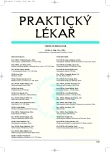Drug-induced gynecomastia
Authors:
J. Heresová 1; Vrzáňovám. 2
Authors‘ workplace:
Endokrinologický ústav Praha
Ředitel: doc. MUDr. V. Hainer, CSc.
Klinika nukleární medicíny 2. LF a FN Motol
Přednosta: doc. MUDr. Petr Vlček, CSc.
1; Interní klinika 2. LF a FN Motol
Přednosta: doc. MUDr. Milan Kvapil, CSc.
2
Published in:
Prakt. Lék. 2007; 87(3): 165-168
Category:
Of different specialties
Overview
Gynecomastia in adult males often results from a drug-induced relative imbalance between concentrations of androgens and estrogens. These hormonal changes are induced by certain drugs or by pathological processes interacting with hormonal secretion, the enzymatic system or with sex steroid receptors. Chronic renal failure, liver disorders, thyrotoxicosis, adrenal hyperplasia or tumours might cause neurohumoral changes that in turn lead to secondary gynecomastia. Several drugs, such as anabolic steroids, digoxin, antihypertensives, some antirheumatic drugs, antidepressants, antiandrogens, neruoleptics and recreational drugs have been proposed to be responsible for drug-induced gynecomastia. Both phytoestrogens and pollutants have been also associated with gynecomastia.
Key words:
secondary gynecomastia, drugs.
Labels
General practitioner for children and adolescents General practitioner for adultsArticle was published in
General Practitioner

2007 Issue 3
Most read in this issue
- Testosterone replacement therapy in aging men.
- Drug-induced gynecomastia
- ACTH-dependent Cushing’s syndrome due to a carcinoid tumour Cushing’s
- Thyroid cancer and malignant lymphoma – is there a relationship?
